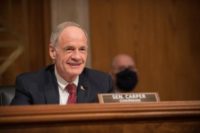Funding for U.S. water infrastructure—specifically for wastewater-treatment facilities—is gaining more attention in the House as advocates push for increased federal investment.
House Transportation and Infrastructure Committee Chairman Peter DeFazio (D-Ore.), backs major facility funding, noting at a Feb 23 hearing, “I’m going to push for a very ambitious number and then we’re going to find ways to pay for it.”
[View webcast of hearing here.]
Rep. Grace Napolitano (D-Calif.), who chairs the committee's water resources and environment subcommittee, said at the hearing that she plans to introduce legislation soon to reauthorize the U.S. Environmental Protection Agency Clean Water State Revolving Fund (SRF) program, the main federal funding resource for wastewater treatment projects.
“Our nation’s network of water infrastructure [is] aging, often outdated and in many places not meeting the needs of our communities or water quality standards,” she said.
Lawmakers and witnesses at the hearing sketched out dimensions of the problem. They cited an EPA report that estimated wastewater treatment/clean water needs at $271 billion over 20 years, although David Mallino, Laborers' International Union of North America legislative and political director, noted that the estimate is nearly a decade old and the need probably has increased since then.
DeFazio did not specify how much money he will seek, but a water infrastructure bill that the committee cleared last September included a $20-billion, five year authorization for clean qater SRFs although it went no further in the 116th Congress.
Another possible signal is the $40 billion authorized for the SRFs in the Moving Forward Act, which the Democrat-controlled House passed last July. The Senate, then controlled by Republicans, failed to act on the legislation.
One possible revenue raiser, DeFazio suggested, is a financial transaction tax that he says could raise $77 billion per year.
But no matter how large that authorization will be, if reauthorization is enacted, funding will be subject to action by the appropriations committees, and as Napolitano noted, the 2021 appropriation for clean water SRFs is just $1.6 billion.
Lima, Ohio, Mayor Dave Berger, testifying for the U.S. Conference of Mayors, said federal clean water SRF funding has been basically flat for decades. As a result, cities and localities have had to shoulder the bulk of overall water infrastructure funding.
Oluwole McFoy, general manager of the Buffalo Sewer Authority and chair of the Buffalo Water Authority, told the panel that the federal government’s estimated share of total U.S. water infrastructure funding is less than 5%.
”Local governments are stuck on an unsustainable financial treadmill,” Berger said, adding that “decisions made by the federal government to eliminate or reduce financial assistance without restricting costly [regulatory] mandates have placed a severe financial burden on us.”
McFoy, testifying for the National Association of Clean Water Agencies, said that as water infrastructure deteriorated, ratepayers were unable to afford the maintenance, repairs and needed replacement of water infrastructure .
He told the subcommittee, “The key to ending this cycle and restoring a sense of equity to our water utility system is having a re-engaged federal partner that is willing to help fund water infrastructure work that will allow cities to modernize their systems.”
Top subcommittee Republican Dave Rouzer (N.C.) agreed that wastewater needs “are substantial and they continue to grow.” But he takes a different approach saying lawmakers should ask, “What funding level is both appropriate and realistic? And how are we going to pay for it?"
Rouser called for an “all hands on deck approach,” which would include federal, state and local investments but also seek new revenue sources and ways to collaborate with the private sector.
He also favors reviewing current regulations to see whether some could be changed or eliminated.



Post a comment to this article
Report Abusive Comment